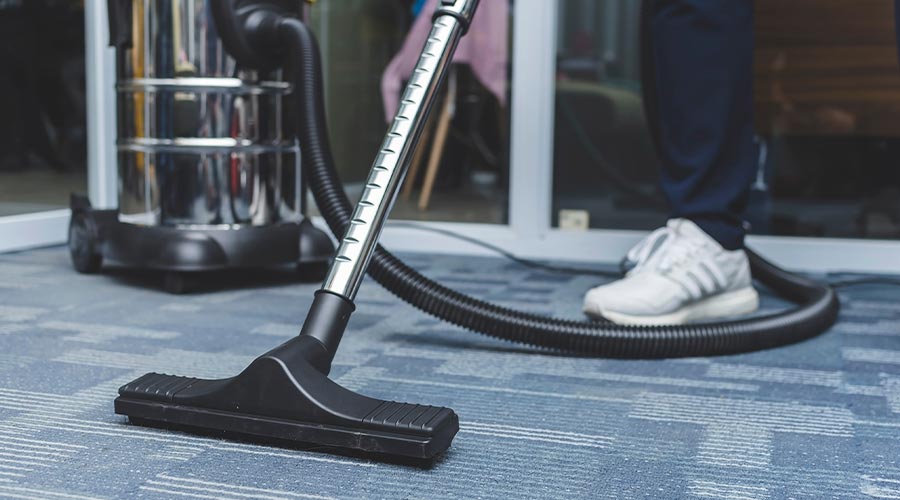
When scheduling and planning the techniques for carpet cleaning, it’s important to remember that not all buildings are created equal. Environmental conditions play a significant role. Facilities in dusty or polluted areas may see dirt and pollutants accumulate faster, affecting both the carpet’s cleanliness and IAQ. Additionally, areas within a facility that are prone to spills or moisture need prompt attention to prevent mold or mildew growth, which will also impact air quality.
In areas that see a significant amount of ice and snow, an acidic rinse product is often required to remove calcium chloride residues from carpets, Clipperton says.
Moving beyond regularly scheduled vacuuming, encapsulation and steam cleaning introduce chemicals and water into the mix. Harsh chemicals can impact IAQ and add moisture to carpet fibers. Not allowing for thorough drying can lead to mold and mildew, which can be released into the air by foot traffic and vacuuming. Even a carpet that appears clean can affect IAQ because of residual chemical smells and moisture.
"Proper drying of carpet helps prevent bacterial and mold growth with related odor, allergens, and Microbial VOCs (MVOCs) produced by fungi and bacteria," says Tawsha Stanford, President, Modern Clean, Eagle, Idaho. "Interim methods, such as encapsulation, use less water and are generally faster, though not a substitute for periodic hot water extraction deep cleaning."
To achieve strong results, Shari Solomon, president of CleanHealth Environmental, LLC in Silver Spring, Maryland, recommends steam cleaning. And while well-executed cleaning methods will result in clean carpets, she notes there exists a distinction between sanitizing and disinfecting carpets.
“According to the Environmental Protection Agency (EPA), only hard surfaces can be disinfected,” she says. “There are EPA disinfectants available to sanitize carpets and other soft surfaces during hot water extraction.”
Understanding the difference between sanitizing and disinfecting as it pertains to carpet and other soft surfaces — and explaining it to customers — is important. This is especially true in facilities where occupants may routinely spend time on or close to the floor, such as in day cares, schools, and healthcare facilities where the risk of spills of blood and other bodily fluids is higher.
Clipperton, pointing to the EPA's Safer Choice cleaning chemicals list, agrees. He comments that cleaning products with toxic or hazardous ingredients, or those that emit irritating fumes should be avoided.
"The impact of chemicals on IAQ can be significant depending on the formulation," says Stanford. "EPA’s SaferChoice program offers a number of options in carpet cleaning solutions that are better for people, planet, and business."
To adequately sanitize carpet, building service contractors must follow the chemical manufacturer’s guidelines on the labels for application, dwell times, and dilution rates.
“Make sure that it's clarified that we recognize we don't disinfect carpets, but we do sanitize,” Solomon says.
Once liquid chemicals and water are introduced into the cleaning process, it's vital to plan for adequate drying time so that moisture doesn't remain trapped in carpet fibers. Drying carpets properly prevents the potential of mold, fungi, mildew, bacteria, or the rise of associated musty odors. These health hazards — which will negatively impact IAQ — may develop if carpet remains wet longer than eight hours. Cleaning is not complete until the carpet is dry and ready for foot traffic. Drying carpet also helps to eliminate slip-and-fall hazards, especially in areas where carpet transitions to hard surfaces.
Wherever possible, cleaning professionals should provide natural (open doors, windows) or mechanical ventilation (fans) during the cleaning and drying phases of deep cleaning. Adequate ventilation is necessary to speed drying time. The use of commercial air movers, HVAC handling systems, or dehumidifiers will greatly reduce drying time.
Protecting Cleaning Pros
While the focus here has been on properly cleaning carpets with an eye towards IAQ for building occupants, cleaning technicians also can be affected by the IAQ of the facilities they clean. Vacuum filtration systems reduce dust while in use, but dust, pollen, and other particles can be released when filters or bags are changed or emptied. If there is the possibility of negative VOCs or airborne particles, face masks or respirators should be worn by cleaning staff.
"Mapping or diagramming the space and/or color-coding high traffic spots for task assignment/cleaning scheduling is also key, as is ensuring good ventilation during and after cleaning," says Stanford. "Ventilation not only removes or dilutes airborne pollutants but helps in drying carpet."
Chemicals used for encapsulation or steam cleaning can be inhaled, accidentally sprayed into the eyes, and absorbed into the skin. When working with chemicals, cleaning staff should have access to personal protective equipment (PPE) such as protective eyewear, disposable gloves, and splash aprons to protect themselves from exposure.
Finally, maintaining cleaning equipment and following manufacturer guidelines for chemical dilution and use contribute to reducing any detrimental impact on IAQ from carpet, as well as protecting janitorial workers. Vacuums should be kept in good working order, filters and bags should be checked and changed regularly, and proper vacuuming technique that keeps the vacuum head firmly on the carpet are essential. Equipment that introduces chemicals and water to the cleaning process also needs routine monitoring, cleaning, and maintenance.
Clipperton recommends equipment and cleaning solutions that carry the CRI's Seal of Approval (SOA) designation. This is the carpet industry’s only scientific program to test the effectiveness of carpet cleaning products and equipment.
Improved IAQ in any facility can be achieved starting from the floor up. Keeping carpeting clean and dry, with a tailored focus on each facility's needs concerning frequency and degree of cleaning and sanitizing, will help building occupants and cleaning professionals breathe easier.
Shannon O'Connor is a freelance writer from Mason, Ohio.
How Carpets Contribute to Facility Air Quality

 Celebrating BSCAI's 60th Anniversary eBook
Celebrating BSCAI's 60th Anniversary eBook The Down and Dirty on Cleaning in Virus Season
The Down and Dirty on Cleaning in Virus Season How Surfactant Use is Expanding in Commercial Cleaning
How Surfactant Use is Expanding in Commercial Cleaning